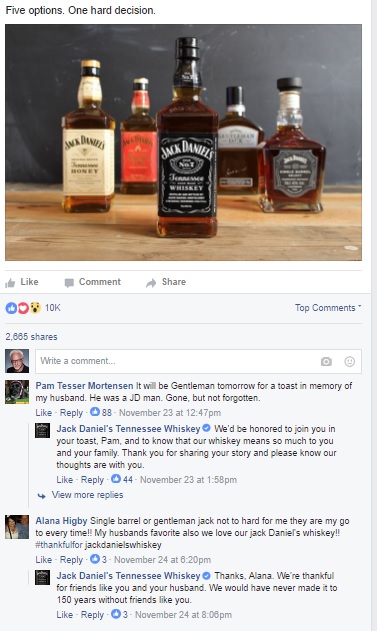
How’s that for a headline? As we head first into the holiday season, there will be much imbibing at company holiday parties and with friends and family.
But it turns out that brewers and distillers are among the best when it comes to social media marketing, connecting with their tribes, and building their brands in an environment that is often challenging.
Unlike radio, alcohol brands face an arduous road. Glorifying their products while not encouraging over-indulgence or usage among under-age consumers is a big part of their marketing tightrope act. There are many harsh observers monitoring the media and marketing activities of these brands, so their work has to be especially good, and if you’ll excuse the expression, crafty.
Recently, Econsultancy’s Nikki Gilliland examined how booze brands are deftly and cleverly navigating the social space, while maintaining an air of responsibility. And as I reviewed her examples, several apply directly to radio brands, shows, and daypart personalities. In the process, I started looking for other examples.
And as it turns out, most alcohol brands do an impressive job of creating a unique vibe socially. Radio can learn a great deal from their “social drinking” techniques and approaches.
Here are five key takeaways about how alcohol brands are connecting with their customers in the social space:
1. Cause marketing
Kronenbourg does an especially good job in this area. In this case, it’s not about charity, but rallying an audience behind a goal. Their #LeBigSwim mobilized their customer base to declare Kronenbourg as their supreme beer by getting them behind former soccer star Eric Cantona. He pledged to swim the English Channel if 10,000 people pledged their support for the beer.
More than 2.5 million fans ended up engaging with the brand on Twitter, with the slogan, “Nothing’s Too Far For Cantona.” It’s a great example of using the power of a personality to rally an audience in the social space.
Announcement très important. Cantona to swim the Channel. Will you support Eric? #LeBigSwimhttps://t.co/PZGErCXzZF
— Kronenbourg 1664 (@Kronenbourg1664) July 2, 2015
There is clearly a radio application here because local personalities are as powerful as celebrity spokespeople representing alcohol brands. The Kronenbourg’s #LeBigSwim is a great example of planning an entire campaign from start to finish, with social media being in the center ring.
2. Personalization
Social media mavens always advise that acknowledgment matters. And while the booze brands highlighted in Gilliland’s analysis tend to excel with video and other engagement tools, there’s no substitute for personal conversations between brands and consumers. The bigger the brand, the more powerful the effect.
And that’s why Jack Daniels’ approach is so interesting. They’re one of the most iconic brands in the world, but not so big they can’t interact with their tribe on Facebook:
This is a reminder to every personality in local radio to find the time to spend a few precious moments with fans on sites like Facebook and Twitter. This kind of validation is what leads to loyalty and recommendation.
A few years back, Dateline NBC’s Josh Mankiewicz did a keynote presentation at Jacobs Summit about his close relationship with his fans on Twitter. Somehow a guy as busy as Mankiewicz makes the time to connect with thousands of his loyal followers in the social space. The formula? Speed, humor, and snark – in that order. Responding and timeliness are the keys to optimizing brand-fan relationships in media and with these alcohol brands.
3. Promoting lifestyles with storytelling
Booze brands often understand there’s more to their customer base than drinking. Too often, radio stations narrowly view their audiences as Classic Rock lovers or sports fans. But that’s rarely how people define themselves. Tapping into the lifestyles and experiences of consumers is a way for any brand to connect with its base. And that’s especially the case for the big names in alcohol.
That’s the approach that Johnnie Walker, another iconic brand, is using on social media. They use hashtags like #KeepWalking and lines like “Let Joy Push You On,” Johnnie Walker uses storylines and celebrities to foster a spirit of aspiration and accomplishment over adversity.
https://twitter.com/johnniewalker_/status/780757604469444608
As NPR’s “Storycorps” proves again and again, every listener has a story. Johnnie Walker’s approach – using themed narratives to inspire their fans is similar in nature to the way “The Moth Radio Hour” silos their stories into ideas and themes. Their “True Stories Told Live” concept underscores the wide appeal of storytelling, something that any defined radio brand could pull off.
4. Cool, sticky content
Carlsberg does an amazing job of using Twitter strategically. With great videos, content, and visuals, they keep their fans engaged with the brand on Twitter without driving them away to other sites. That makes it easy for consumers to get the Carlsberg message on Twitter while scanning through social news feeds. Here’s an example of a simple message about drinking and driving, typical of the Carlsberg approach.
Enjoy your Carlsberg without the Car. #GlobalBeerResponsibilityDay. #CheersResponsibly https://t.co/mxTPbCH1jB pic.twitter.com/xsnZvXTfut
— Carlsberg (@carlsberg) September 16, 2016
This is such a smart idea because Carlsberg keep its fans engaged with its content. So often, radio moves its audience around the web, and we know how easy it can be to get lost while surfing, clicking, and “liking.”
5. Video, video, video
It’s starts on a YouTube channel loaded with cool, unassuming, short videos. That’s the approach of Lagunitas Beer. Some of the videos capture the vibe and excitement of events where their beer is being joyfully consumed. But others are part of the #Mouthfeels series, like this Lagunitas Sucks video. Yes, one of their ale brands is called “Sucks.”
Lagunitas reminds us that YouTube isn’t just a place to watch short homemade videos – it’s a social media site if monster proportions. And video, of course, is key to keeping audiences engaged. You see it permeate these other examples, but in Lagunitas’s case, they’re doubled down on the format with videos that have a distinct attitude and point of view. Many radio brands are well down this road, but perhaps don’t have their video libraries organized and set up in a way their audiences can easily peruse and enjoy them. Videos can live forever in the social space, making it great for stations and personalities to offer up experiences that are fun, interesting, or even informative.
Given the sensitivity alcohol brands have to take into account in their marketing, you can see just how much they pour into their efforts. Yes, they have more resources to work with than the average radio station. But their techniques, methods, and processes are what are worth emulating. Nothing occurs by chance in the social space. It is all connected to an overriding strategy, and that’s the point of learning from these alcohol brands that are, in fact, lifestyle products. Just like radio.
Developing that social “umbrella strategy” isn’t easy, but it can pay off in big ways. A brainstorm with the programming, sales, and marketing teams over a couple of beers just might unlock some of the techniques and tactics that will work with your brand.
And remember, it’s 5 o’clock somewhere.
- What To Do If Your Radio Station Goes Through A Midlife Crisis - April 25, 2025
- A 2020 Lesson?It Could All Be Gone In A Flash - April 24, 2025
- How AI Can Give Radio Personalities More…PERSONALITY - April 23, 2025




Great article… small typo: “site if monster proportions”
Thanks – I need a better proofreader. 🙂
I just did the Bourbon Trail here in Kentucky. The key line shared at Buffalo Trace Distillery was “the best bourbon is the one you like.”
What each of the distilleries I visited shared was promotion of the product, no matter the maker. Promote bourbon first and your personal brands second.
There’s a lesson here for all of us.
Many thanks, Dick. The radio industry could use some of the holiday spirit – no pun intended. Thanks for the insight.